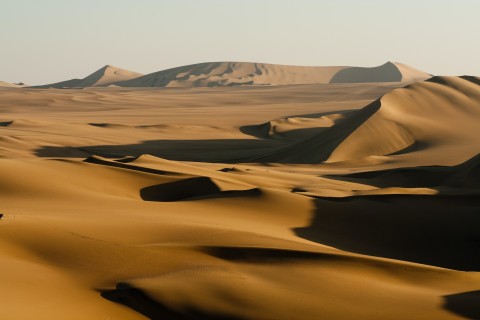Has the desert of quarantine already taught us all it can?
Those of us privileged enough to stay at home have to go back to work eventually. Will we go back to our former distraction?

In March, the desert sands blew up to our doorsteps.
“We are all monks now,” a friend texted me shortly after the quarantine began. But we didn’t become Benedictines so much as desert hermits. And our primary spiritual practice became the simplest and most difficult of all: stay.
“Stay in your cell, and your cell will teach you everything,” goes the most famous saying of desert spirituality. And many of us have done just that, insofar as we could. Previously purchased concert tickets sat unused in a drawer, and instead we watched our favorite musicians perform on Facebook. We joined Sunday morning worship on our phones. We attended staff meetings in our pajamas, seated at the kitchen table. Yes, we took walks, but we walked alone, endeavoring not to break quarantine, even outside. We stayed as much as possible in the hermitages of our homes.
Now, in many states, the sands are receding: restrictions on movement are being lifted, stores are reopening, restaurants are welcoming diners, barbers are cutting hair, and churches are planning how they can worship again in person.
But have we learned all our cells have to teach us?
Those early monks fled to the desert in order to discover the truth of themselves and the truth of their God, the twin discoveries foundational for a life of holiness. The distractions of life in the city made such discoveries nearly impossible, especially as the church’s increasingly cozy relationship with power watered down, in their eyes, the demands of discipleship. So they relocated to the desert and took up residence in their cells.
When they fled to the harsh physical landscape of the desert they were finally able to see the true spiritual landscape of their inner lives. Without the typical distractions, they had little to do but pray and observe their own thoughts—the feelings, emotions, fantasies, and temptations that comprised the inner desert of their lives.
And after about ten minutes of watching that inner video loop, who wouldn’t want to run back to the city? Where did I put those tickets to this weekend’s gladiator match?
Yet many of them stuck it out.
About ten weeks ago, many of our distractions were taken away from us: college and professional sports, mindless shopping trips, the pleasing distractions of socializing. The quintessential American get-up-and-go got-up-and-went. Of course, we could still binge-watch our streaming service of choice and scroll through Facebook. But even those activities couldn’t fill all the hours.
Consequently, we had more time than usual to explore the landscape of our own inner lives. What many of us found was the terror of facing the fragility of human existence. No doubt the trauma of a pandemic increased that terror, but some of the reported uptick in anxiety might simply have resulted from living bereft of our go-to resources for escape. We finally started witnessing what was always there.
I’m reminded of how, years ago, when I took a class in mindfulness-based stress reduction, the instructor warned us that our anxiety would get worse before it got better—precisely because we were going to pay attention to it, for once, and not avoid it.
No wonder we are itching to reopen. Who would want to stay home and keep facing the inner terror, keep watching what’s always streaming on the screen of our inner life—fear, anxiety, boredom, fantasy, temptation? Who wouldn’t rather shop?
But the monks of old might warn us: Don’t leave your cell prematurely. It gets worse before it gets better. And you might not have stayed long enough to get to better.
Better names the discovery that the landscape of inner terror isn’t the truest thing about us. The truth, if we wait and pray and persevere long enough for it to reveal itself, is that our lives—our truest selves—are “hidden with Christ in God” in a place of stillness, safety, and hope. A place deeper and truer than our fantasy and fear, anxiety and temptation. A place where we can learn to live no matter where we are, if we don’t hurry away before we ever get there.
Of course we have to shop some and go back to work eventually, those of us who have been able, because of our relative privilege, to observe stay-at-home orders. But maybe there is some wisdom in listening to these monks. Maybe when the desert sands recede by governmental fiat, we might want to build into our lives some of the desert we have experienced. Maybe not rush to fill every void possible. Maybe not indulge as much as we used to our typical modes of distraction. Maybe leave our phones on do-not-disturb more often. Maybe sit in silence and watch our thoughts, even when we don’t have to.
Maybe ask God to give us the grace of self-discovery and not run away when God begins to answer that prayer. Remember, it gets worse before it gets better.
Maybe pray for and practice the patience that might get us to better.
And then maybe engage the world—our families, our friends, our coworkers, the suffering, the marginalized—from that place of stillness, safety, and hope where we abide with God in a divine hermitage of love. That way of connecting with life beyond our cells would be better for everyone.




